Figurative art, with its portrayal of the human form, has a profound and enduring presence in the art world. By tracing its historical roots, we can gain insights into the development and evolution of this artistic genre. In this article, we will explore how we trace the origin and history of art, and delve into the fascinating journey of how figurative art has evolved over the years.
Tracing the origin and history of art is a complex endeavour that requires a multidisciplinary approach. By studying ancient artefacts, cave paintings, and archaeological findings, art historians have unearthed evidence of early artistic expressions dating back tens of thousands of years. The origins of art history can be traced to the ancient civilisations of Mesopotamia, Egypt, and Greece, where art served religious, cultural, and political purposes.
Fast forward to the Renaissance period in Europe, and we witness a revival of interest in human anatomy and the realistic portrayal of figures. Artists like Leonardo da Vinci and Michelangelo ushered in a new era of figurative art, showcasing the beauty and complexity of the human body.
Over the centuries, figurative art has undergone remarkable transformations. The realism of the Renaissance gave way to the Baroque period, characterised by dramatic lighting and emotional intensity. The Impressionists in the 19th century shattered traditional conventions, focusing on capturing the fleeting moments of light and colour, thereby infusing a sense of movement into their figurative works.
In the 20th century, artistic movements such as Cubism, Surrealism, and Abstract Expressionism pushed the boundaries of figurative art even further. Artists like Pablo Picasso, Salvador Dalí, and Jackson Pollock challenged traditional representations, exploring new ways to depict the human form and evoke emotions.
The advent of technology in the 21st century opened up new avenues for artistic expression. Digital art and multimedia installations allowed artists to experiment with different materials and techniques, blurring the lines between figurative and abstract art.
Today, figurative art continues to evolve and adapt, reflecting the changing cultural and social landscapes. Contemporary artists embrace a wide range of styles and mediums, merging traditional techniques with innovative approaches. From hyperrealistic portraits to abstract interpretations of the human form, figurative art remains a powerful means of self-expression and social commentary.
The evolution of figurative art is a testament to the enduring fascination with the human form and the artistic exploration of its complexities. By tracing its rich historical roots, we gain a deeper understanding of how art has evolved over the years, pushing boundaries and challenging perceptions. Figurative art continues to captivate and inspire, leaving an indelible mark on the artistic landscape.

